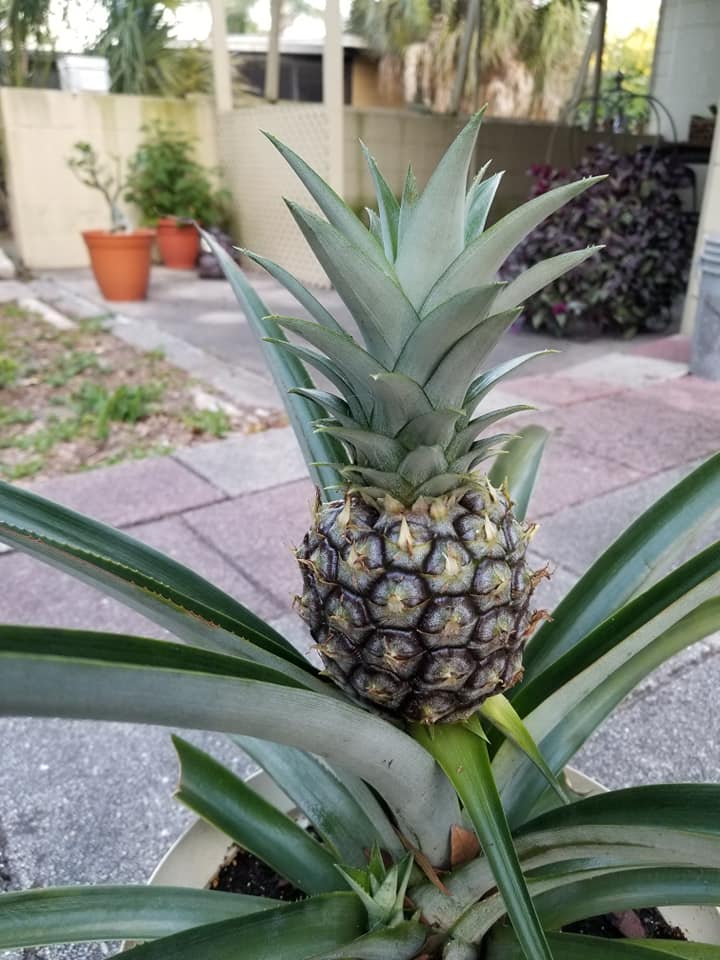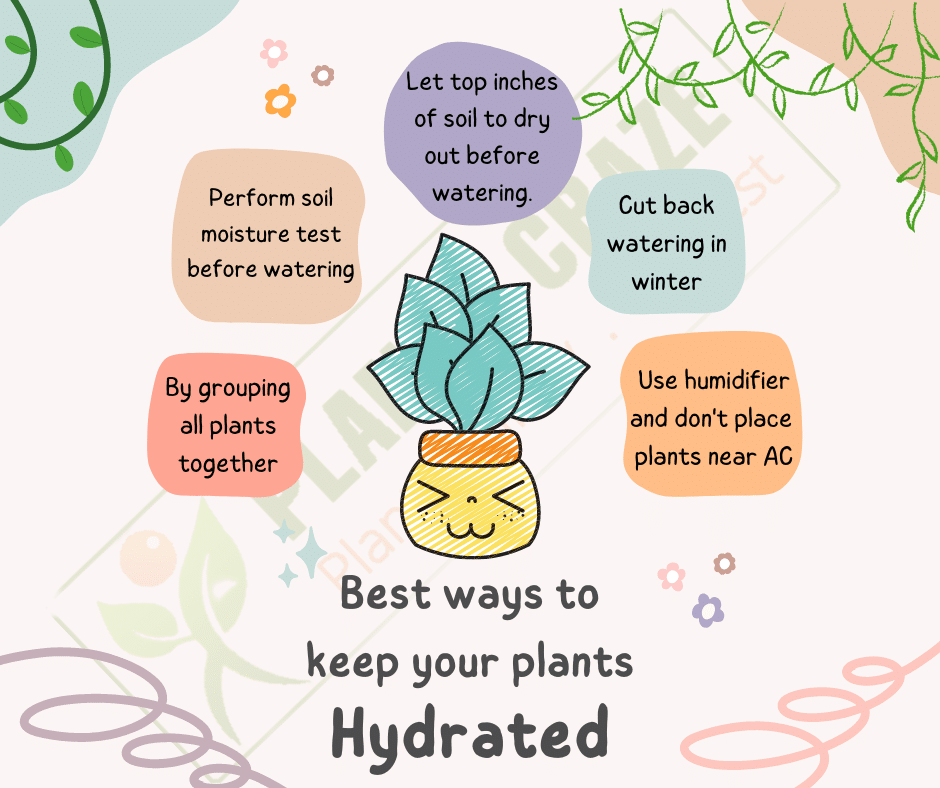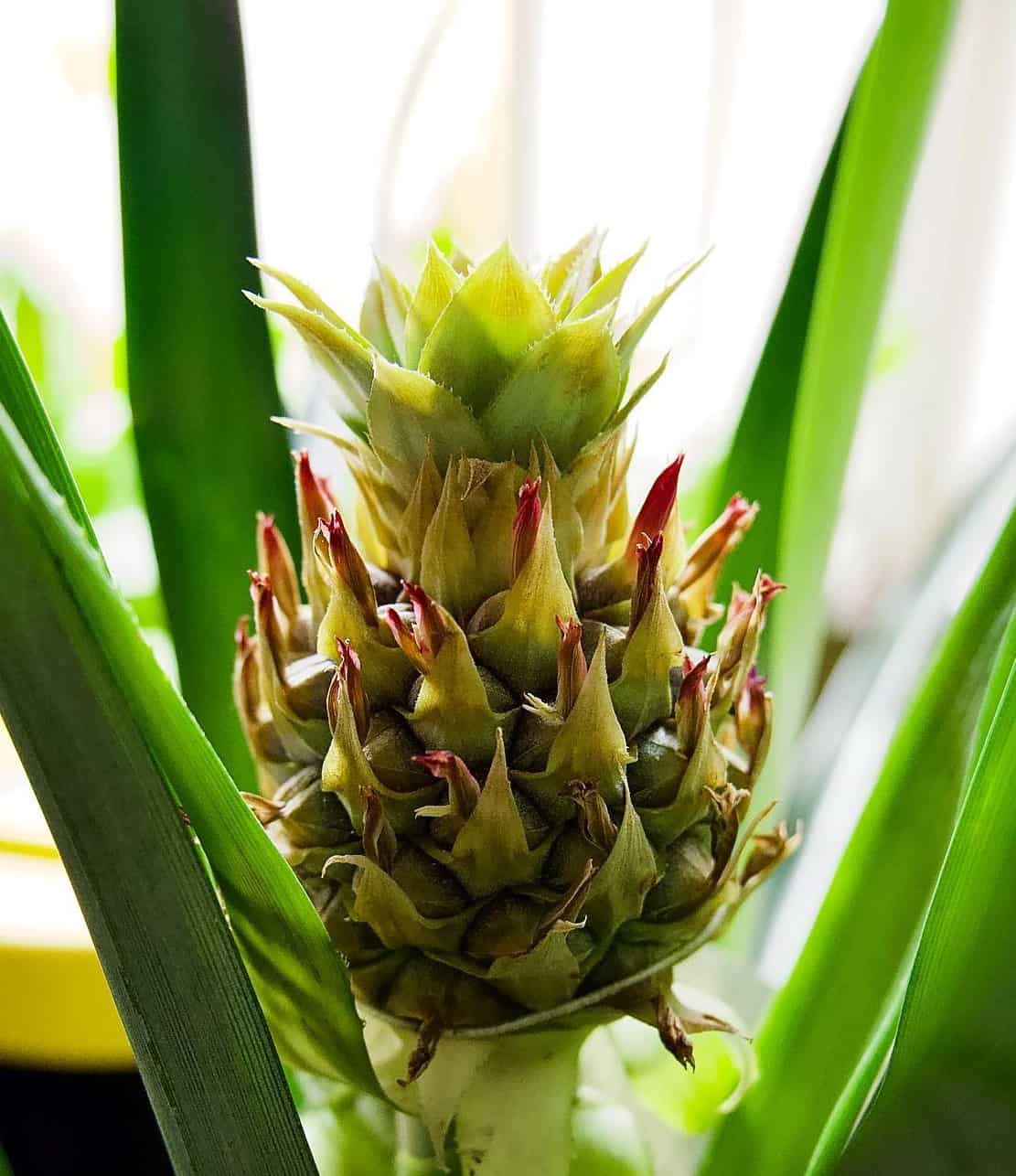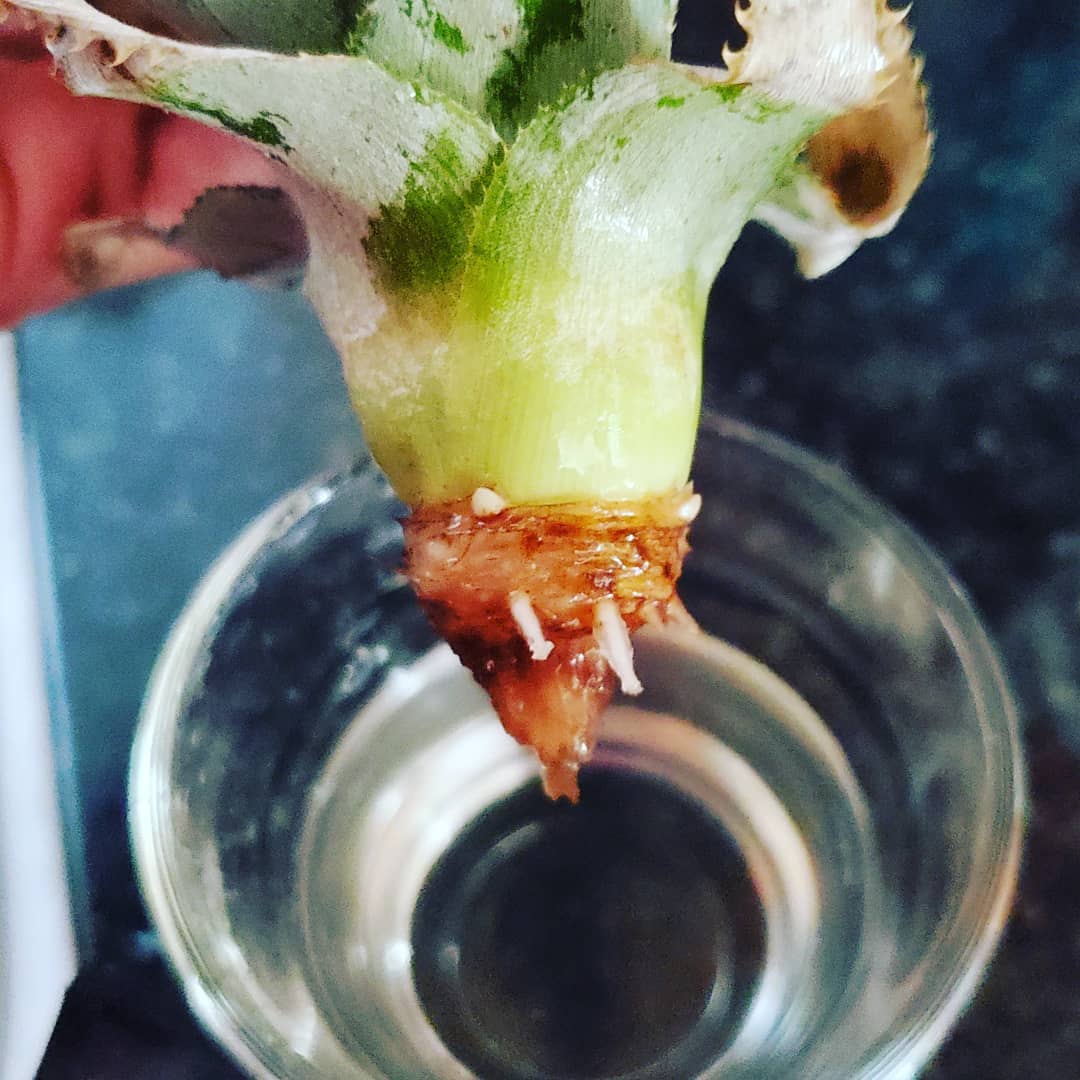Despite their compact size, baby pineapple produces sweet fruit after 2-3 years, but they demand ideal sunshine to make one.
Continue reading if you are thinking about growing a pineapple from scratch, i.e., taking care of a baby pineapple.
Table of Contents Show
Overview of Baby Pineapple
Pineapple plants are beneficial members of the Bromeliaceae family and produce tropical fruits rich in vitamins and enzymes.
These plant groups are called ‘bromeliads,’ mostly tropical epiphytic varieties producing unusual blooms and leaves.

However, the baby pineapple plants must undergo a series of growth phases to finally beget fruits, which is a hefty process.
| Feature(s) | Description(s) |
|---|---|
| Scientific Name | Ananas comosus |
| Common Name | Pineapple Ananas Piña |
| Native | Tropical Rainforests of South America (Northern & Central) |
| Family | Bromeliaceae |
| USDA Zones | 10-12 |
| Plant Type | Perennial Tropical Evergreen Herb or Sub-shrub |
| Plant Size | 3-6 feet tall with equal spread |
| Growth Rate | Moderate to Fast |
| Leaf | Grayish or slivery green rosette arrangement with pointy tips and serrated margins |
| Blooming Period | About 2-3 years following vegetative phase between early spring and summer |
| Flowers | Axillary inflorescence consisting 50-200 bisexual flowers |
| Fruit | 6-12 inch oval or egg-shaped greenish-yellow to orange |
| Toxicity | Non-toxic to humans and cats Gastro-sensitive to dogs |
But, baby pineapples are prone to many deficiencies and diseases if not cared for.
Thus, let us dive deep into how to provide optimum care to them.
Baby Pineapple Plant Care Guide
All the cultivars of pineapples have extreme requisites thriving in moderate conditioning like other tropical plants.
One can easily grow a pineapple in their backyard with little care and effort.

1. Light & Temperature
Daily 6 hours of bright sunlight alongside 68-86°F warmth ensures the total growth of baby pineapples.
Low light and severe cold (<30°F) can slow plant growth and discourage fruiting with brown-flecked leaves. If not helped in time, the fruits can rot.
However, baby pineapple thrives best in a hot, warm environment with direct sunlight. For optimal growth, rotate the baby pineapple plant now and then.
Also, protect them from cold using frost blankets, 2-6 inch layered mulch of wood chips and tree barks, or heat pads.
Note: Use of grow lights will not aid and result in fruiting. Thus, you must ensure full sunlight for them to produce fruit.
2. Water & Humidity
Baby pineapple is a drought-resistant plant with moderate humidity (~60%) needs.
Otherwise, water them once the soil looks or feels dry using a chopstick or moisture meter.
Arid conditions can induce yellow or greyish, wilted leaves and stunted growth in baby pineapple plants.
However, too much water and humidity invite fungal diseases, pests, and root rot with yellow leaves.
Thus, carefully adjust the watering schedule considering the changing temperatures and use mini watering cans to water the soil directly.
3. Soil & Fertilizer
Baby pineapple grows to full potential in nutrient-rich sandy loam soil with bimonthly fertilization.
The risk of overfertilization is high in winter due to low nutrient uptake caused by dormancy. So, better avoid fertilization in winter.

Excess fertilizer can cause salt buildup in the soil resulting in chemical burns and curling leaf tips.
Likewise, nutrient deficiency results in stunted growth of the plant. Furthermore, they may not even produce fruit.
Thus, prepare a mix using coarse sand, peat moss, composted leaves, and humus. Moreover, ensure to fertilize every 2 weeks after flowering.
4. Occasional Pruning
Baby pineapples need pruning once you notice brown tips and wilting leaves at the base of the plant.
Generally, mealy bugs, scales, thrips, and fruit borers are the common pests that trouble baby pineapples.
Meanwhile, fungal diseases like top rot, root rot, fusariosis, and fruitlet core rot infect the plant.
Once infected, pruning and applying effective copper-rich fungicides is the only way to salvage the plant.
Similarly, for plant upkeep, you shall prune them 1-2 months after the end of the harvest in late summer.
But refrain from pruning baby pineapples in winter to avoid the risk of cutting new offshoots.
5. Potting & Repotting
Baby pineapples are slow growers and stay put in a 10-12 inches wide and deep pot without frequent repotting.
While choosing the pot, ensure they have multiple drain holes to let out excess water.
Moreover, presoak the soil a night before repotting to lower repotting stress in baby pineapples.
Generally, a plastic pot with functioning basal drainage holes is best, as it also helps retain moisture.
While repotting, carefully remove the offshoots for propagation and repot them without damaging the mother plant.
Baby Pineapple Plant: All About Growth
As herbaceous perennials, pineapple roots give way to sending new top growth every year.
However, pineapples can become 3-6 feet tall with a similar spread.
They are usually short with a stout stem, decorated spirally with strap-like rosette leaves, pointy tips, and serrated margins.

Pineapples have different leaf colors varying from a uniform green to variously striped red, yellow, or ivory down the middle or at the margins.
They produce about 50-200 flowers that fuse into a single fruit and are capped with a crown hosting short leaves.
Additionally, a single plant produces a single bloom with a typical bromeliad flower structure.
The plant fruits on a 2-3 year crop cycle to complete and harvest.
Each pineapple plant can produce only flowers and fruit once, but the primary plant frequently generates offsets after blooms.
After producing the fruit, the pineapple tends to die but is alive through its suckers.
The fruit is sweet with tough leathery skin and has spiky leaves on the top.
There is a concept called ‘force fruiting’ where you can make the pineapple produce fruit against its natural will.
Forcing Pineapple to Flower & Fruit
To encourage flowers in pineapple plants, utilize ethylene, acetylene, or the plant hormone auxin, called ‘forcing,’ ‘closing out,’ or ‘induction.’
Pineapple plants are sprayed with the growth regulator to encourage consistent flowering.
However, forcing pineapple blossoms causes stress resulting in little fruit on small plants.
Moreover, they have a shorter shelf life and can not be stored with other pineapples.
Also, forced fruit’s acid level is higher than regular fruit’s.

Are Baby Pineapples Toxic?
According to ASPCA, pineapples or other cultivars are non-fatal to humans and pets.
Furthermore, pineapple contains bromelain, an enzyme that tenderizes meat. It causes mouth burn, itch, swelling, and even bleeding in severe conditions.
Bromelain tries to break down the protein content in your mouth, so eating pineapple means it’s eating you back.
If you cut a pineapple fruit with a knife, it releases juices, which can be an irritant to your skin.
Therefore, carefully wash the exposed area with soapy water if you develop such symptoms.
Although pineapple consumption seldom leads to medical attention, you must seek help if you or your pets are on other medications.
How to Propagate Baby Pineapple Plants?
Baby pineapple can be propagated via top crowns, ratoons or suckers, and seeds.
But the seed and crown propagation takes much longer than suckers.
Before hopping on the propagation, gather rooting hormone, fresh potting mix, and a gardening knife.
1. How to Propagate Pineapple Crowns?
Select a healthy pineapple fruit and gently remove the top part and crown using a sterilized knife.
- Remove excessive leaves from its base and dry the crown in the sun for a week.
- Further, dip the base of your plant in water into rooting hormone powder.
- Prepare a pot with sandy loam and well-draining soil with organic perlite.
- After, push the pineapple crown into the soil with your hand.
- Water the stalk gently using spray bottles.
- Avoid using any fertilizer immediately after propagating.
Alternatively, to propagate pineapple crowns, keep the crowns flat with the cut part dipped in 1 inch of water.
It will take about 1-3 months for your pineapple to root.
Your pineapple will start sprouting new leaves from the center after it firmly roots.
Repot the plant in a 10-12 inches wide container with organically rich, well-draining potting mix.

2. How to Propagate Pineapple Pups or Suckers?
Look for the suckers between the leaves of a mature pineapple.
The suckers must be at least 8 inches long to propagate.
- Gently twist it and pull it off to remove it from the base.
- Remove dead leaves from the sucker’s base.
- Prepare a potting mix for the pineapple and mix some perlite.
- Push the sucker into the soil and firm the soil around its base to prevent falling over.
- Add a small amount of water to the soil if it is dry.
Pineapple takes 18 months to grow from suckers, comparatively faster than from crown, which takes 24 months.
From Editorial Team
Conclusion!
Even the tiny, compact size of a baby pineapple can give you one of the sweetest fruit when provided with optimal care.
But maintain at least 5 feet distance while planting the pineapples outdoors, ensuring optimal sunlight.


